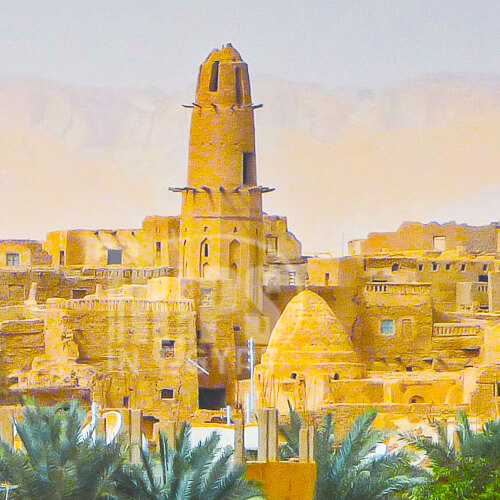No other nation in the world says ‘Welcome’ as often as the Egyptians, and every time, they mean it. While the ancient civilization of Egypt continues to amaze, contemporary Egyptians are equally remarkable.
Only Here
Unveiling the Mysteries of Al-Qasr: A Timeless Islamic Village in Dakhla Oasis
Nestled in the heart of Egypt’s Dakhla Oasis, Al-Qasr village stands as a remarkable testament to Islamic heritage, renowned as the most intact Islamic village still in existence. Located northwest of Mut, along the Sioh Ridge, Al-Qasr majestically defines the northern boundary of the oasis. Its continuous habitation and exceptional preservation make it unparalleled among settlements in Dakhla.
Believed to have been founded by the Ayyubids towards the late 12th century, Al-Qasr (literally ‘The Fortress’) evolved from the remnants of a Roman settlement. Its strategic position and fortified structure were ingeniously designed to ward off invading armies from the west and south.
The village’s narrow, shaded streets, reminiscent of the ancient town of Mut, are divided into quarters, each historically secured at night by gated fences. While the passage of time has brought changes, Al-Qasr has retained its distinctive three-story mudbrick minaret, which towers 21 meters above the mosque of Nasr el-Din from the Ayyubid era. This minaret is a solitary survivor from the original mosque; the rest was reconstructed in the 19th century.
Within the mosque lies the mausoleum of Sheikh Nasr el-Din, adorned with beautifully inscribed wooden lintels above the entrances. The ancient madrasa, once a center for Quranic learning, has evolved into a multifunctional school and public meeting place, open for visitors to explore.
Another highlight for visitors is the meticulously preserved Abu Nafir’s house, a towering structure with a heavy wooden door crafted from a Ptolemaic temple. The door jambs, featuring a melange of symbols, predominantly from repurposed blocks, narrate stories from a bygone era.
Wandering through the cool, meandering alleyways of Al-Qasr, one is treated to spectacular views of intricately carved lintels and beams that grace the entrances of many houses, blending ancient artistry with modern aesthetics.
The village is rich in historical inscriptions, with the oldest found on Beit Ibrahim, dating back to the 15th century. Recent discoveries, including a corn-mill and pottery factory furnaces, hint at a vibrant post-antiquity community. Today, nearly 700 residents, predominantly craftsmen, call Al-Qasr home, renowned for their skill in creating earthenware pots and palm-leaf baskets.
Interestingly, those who leave Al-Qasr cannot return to reside, as the Ministry of Antiquities claims deserted houses, and new construction is prohibited, preserving the village’s historical integrity.
Under the Dakhla Oasis Project, Al-Qasr has been the focus of extensive archaeological study and restoration efforts. Investigations have revealed the possibility of a pre-existing Roman fortress beneath the village, with some suggesting that the Roman camp, Takastra, lies beneath today’s Al-Qasr.
Al-Qasr, with its rich tapestry of history, architecture, and craftsmanship, offers a unique window into the Islamic era of Egypt, standing as a beacon of cultural preservation and historical continuity in the stunning landscape of the Dakhla Oasis.
Created On March 18, 2020
Updated On Aug , 2024
Dakhla Oasis Travel Guide



